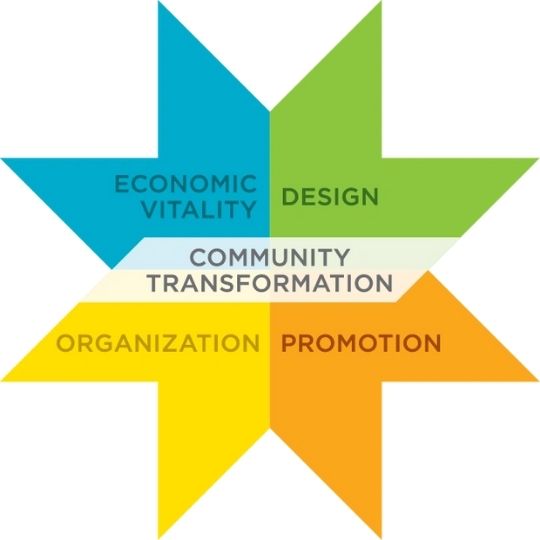Main Street Four Point Approach

The Main Street Four-Point ApproachTM is a unique preservation-based economic development tool that enables communities to revitalize downtown and neighborhood business districts by leveraging local assets - from historic, cultural, and architectural resources to local enterprises and community pride. It is a comprehensive strategy that addresses the variety of issues and problems that challenge traditional commercial districts.
Since its founding in 1980, Main Street has been the leader than 2,000 programs and leaders who use the Main Street approach to rebuild the places and enterprises that create sustainable, vibrant communities. This approach has been implemented in over 1,200 cities and towns in 40 states across the nation with the help of the National Main Street Center and statewide downtown revitalization programs.
The success of the Main Street approach is based on its comprehensive nature. By carefully integrating four points into a practical downtown management strategy, a local Main Street program will produce fundamental changes in a community’s economic base.
Organization involves building a Main Street framework that is well represented by business and property owners, bankers, citizens, historic preservationists, entrepreneurs, public officials, chamber of commerce, and other local economic development organizations. Everyone must work together to renew downtown. A strong organization provides the structure and stability to build and maintain along-term effort.
Promotion creates excitement and vibrancy downtown. Street festivals, parades, retail events, and image development campaigns are some of the ways Main Street provides education on what’s downtown and encourages customer traffic Promotion involves marketing an enticing image to shoppers, investors, and visitors.
Design enhances the look and feel of the historic district. Historic building rehabilitation, street and alley clean-up, landscaping, street furniture, signage, visual merchandising and lighting all improve the physical image of the downtown as a quality place to shop, work, walk, invest in, and live. Design improvements result in a reinvestment of public and private dollars to downtown.
Economic Vitality involves analyzing current market forces to develop long-term solutions. Recruiting new businesses, creatively converting unused space for new uses, and sharpening the competitiveness of Main Street’s traditional merchants are examples of economic restructuring activities.